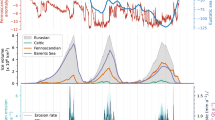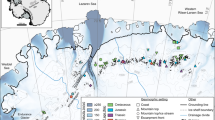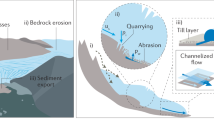Abstract
Glacial erosion is fundamental to our understanding of the role of Cenozoic-era climate change in the development of topography worldwide, yet the factors that control the rate of erosion by ice remain poorly understood. In many tectonically active mountain ranges, glaciers have been inferred to be highly erosive, and conditions of glaciation are used to explain both the marked relief typical of alpine settings and the limit on mountain heights above the snowline, that is, the glacial buzzsaw1. In other high-latitude regions, glacial erosion is presumed to be minimal, where a mantle of cold ice effectively protects landscapes from erosion2,3,4. Glacial erosion rates are expected to increase with decreasing latitude, owing to the climatic control on basal temperature and the production of meltwater, which promotes glacial sliding, erosion and sediment transfer. This relationship between climate, glacier dynamics and erosion rate is the focus of recent numerical modelling5,6,7,8, yet it is qualitative and lacks an empirical database. Here we present a comprehensive data set that permits explicit examination of the factors controlling glacier erosion across climatic regimes. We report contemporary ice fluxes, sliding speeds and erosion rates inferred from sediment yields from 15 outlet glaciers spanning 19 degrees of latitude from Patagonia to the Antarctic Peninsula. Although this broad region has a relatively uniform tectonic and geologic history, the thermal regimes of its glaciers range from temperate to polar. We find that basin-averaged erosion rates vary by three orders of magnitude over this latitudinal transect. Our findings imply that climate and the glacier thermal regime control erosion rates more than do extent of ice cover, ice flux or sliding speeds.
This is a preview of subscription content, access via your institution
Access options
Subscribe to this journal
Receive 51 print issues and online access
$199.00 per year
only $3.90 per issue
Buy this article
- Purchase on Springer Link
- Instant access to full article PDF
Prices may be subject to local taxes which are calculated during checkout


Similar content being viewed by others
References
Egholm, D. L., Nielsen, S. B., Pedersen, V. K. & Lesemann, J.-E. Glacial effects limiting mountain height. Nature 460, 884–887 (2009)
Thomson, S. N. et al. Glaciation as a destructive and constructive control on mountain building. Nature 467, 313–317 (2010)
Koons, P. O. The topographic evolution of collisional mountain belts: a numerical look at the Southern Alps, New Zealand. Am. J. Sci. 289, 1041–1069 (1989)
Stroeven, A. P., Fabel, D., Hatterstrand, C. & Harbor, J. A relict landscape in the centre of the Fennoscandian glaciation: cosmogenic radionuclide evidence of tors preserved through multiple glacial cycles. Geomorphology 44, 145–154 (2002)
Egholm, D. L., Pedersen, V. K., Knudsen, M. F. & Larsen, N. K. Coupling the flow of ice, water, and sediment in a glacial landscape evolution model. Geomorphology 141–142, 47–66 (2012)
Herman, F., Beaud, F., Champagnac, J.-D., Lemieux, J.-M. & Sternai, P. Glacial hydrology and erosion patterns: a mechanism for carving glacial valleys. Earth Planet. Sci. Lett. 310, 498–508 (2011)
Yanites, B. & Ehlers, T. A. Global climate and tectonic controls on the denudation of glaciated mountains. Earth Planet. Sci. Lett. 325–326, 63–75 (2012)
Tomkin, J. H. Numerically simulating alpine landscapes: the geomorphic consequences of incorporating glacial erosion in surface process models. Geomorphology 103, 180–188 (2009)
Hallet, B., Hunter, L. & Bogen, J. Rates of erosion and sediment evacuation by glaciers: a review of field data and their implications. Global Planet. Change 12, 213–235 (1996)
Koppes, M. & Montgomery, D. The relative efficacy of fluvial and glacial erosion over modern to orogenic timescales. Nature Geosci. 2, 644–647 (2009)
Koppes, M., Hallet, B. & Anderson, J. Synchronous acceleration of ice loss and glacier erosion, Marinelli Glacier, Tierra del Fuego. J. Glaciol. 55, 207–220 (2009)
Szczuciński, W., Zajączkowski, M. & Scholten, J. Sediment accumulation rates in subpolar fjords—impact of post-Little Ice Age glaciers retreat, Billefjorden, Svalbard. Estuar. Coast. Shelf Sci. 85, 345–356 (2009)
Cowton, T., Nienow, P., Bartholomew, I., Sole, A. & Mair, D. Rapid erosion beneath the Greenland Ice Sheet. Geology 40, 343–346 (2012)
Fernandez, R. A., Anderson, J. B., Wellner, J. S. & Hallet, B. Timescale dependence of glacial erosion rates: a case study of Marinelli Glacier, Cordillera Darwin, southern Patagonia. J. Geophys. Res. 116, F01020 (2011)
MacGregor, K. R., Anderson, R. S. & Waddington, E. D. Numerical modeling of glacial erosion and headwall processes in alpine valleys. Geomorphology 103, 189–204 (2009)
Kessler, M. A., Anderson, R. S. & Briner, J. P. Fjord insertion into continental margins driven by topographic steering of ice. Nature Geosci. 1, 365–369 (2008)
Hallet, B. Glacial quarrying: a simple theoretical model. Ann. Glaciol. 22, 1–8 (1996)
Iverson, N. R. A theory of glacial quarrying for landscape evolution models. Geology 40, 679–682 (2012)
Cowan, E. A. et al. Fjords as temporary sediment traps: history of glacial erosion and deposition in Muir Inlet, Glacier Bay National Park, southeastern Alaska. Geol. Soc. Am. Bull. 122, 1067–1080 (2010)
Boldt, K. V. et al. Modern rates of glacial sediment accumulation along a 15 ° S‐N transect in fjords from the Antarctic Peninsula to southern Chile. J. Geophys. Res. 118, 2072–2088 (2013)
Cuffey, K. M., Conway, H., Hallet, B., Gades, A. & Raymond, C. F. Interfacial water in polar glaciers and glacier sliding at −17 °C. Geophys. Res. Lett. 26, 751–754 (1999)
Hooke, R. & Elverhøi, A. Sediment flux from a fjord during glacial periods, Isfjorden, Spitsbergen. Global Planet. Change 12, 237–249 (1996)
Humphrey, N. F. & Raymond, C. F. Hydrology, erosion and sediment production in a surging glacier: Variegated Glacier, Alaska, 1982–83. J. Glaciol. 40, 539–552 (1994)
Griffith, T. W. & Anderson, J. B. Climatic control of sedimentation in bays and fjords of the northern Antarctic Peninsula. Mar. Geol. 85, 181–204 (1989)
DaSilva, J. L., Anderson, J. B. & Stravers, J. Seismic facies changes along a nearly continuous 24° latitudinal transect: the fjords of Chile and the northern Antarctic Peninsula. Mar. Geol. 143, 103–123 (1997)
Hebbeln, D., Lamy, F., Mohtadi, M. & Echtler, H. Tracing the impact of glacial-interglacial climate variability on erosion of the southern Andes. Geology 35, 131–134 (2007)
Domack, E. W. & McClennen, C. E. Accumulation of glacial marine sediments in fjords of the Antarctic Peninsula and their use as late Holocene paleoenvironmental indicators. Antarct. Res. Ser. 70, 135–154 (1996)
Rignot, E., Rivera, A. & Casassa, G. Contribution of the Patagonia Icefields of South America to sea level rise. Science 302, 434–437 (2003)
Rau, F. & Braun, M. The regional distribution of the dry-snow zone on the Antarctic Peninsula north of 70° S. Ann. Glaciol. 34, 95–100 (2002)
Sukakibara, D. & Sugiyama, S. Ice-front variations and speed changes of calving glaciers in the Southern Patagonia Icefield from 1984–2011. J. Geophys. Res. 119, 2541–2554 (2014)
Lenaerts, J. T. M., van den Broeke, M. R., van den Berg, W. J., van Meijgaard, E. & Kuipers Munneke, P. A new, high‐resolution surface mass balance map of Antarctica (1979–2010) based on regional atmospheric climate modeling. Geophys. Res. Lett. 39, L04501 (2012)
Morris, E. M. & Vaughan, D. G. in Antarctic Peninsula Climate Variability (eds Domack, E. et al.) Vol. 79 of Antarctic Research Series 61–68. (American Geophysical Union, 2003)
Dalziel, I. W. D. et al. The Scotia arc: genesis, evolution, global significance. Annu. Rev. Earth Planet. Sci. 41, 767–793 (2013)
Breitsprecher, K. & Thorkelson, D. J. Neogene kinematic history of Nazca–Antarctic–Phoenix slab windows beneath Patagonia and the Antarctic Peninsula. Tectonophysics 464, 10–20 (2009)
Guillaume, B. et al. Dynamic topography control on Patagonian relief evolution as inferred from low temperature thermochronology. Earth Planet. Sci. Lett. 364, 157–167 (2013)
Mayr, C. et al. Holocene variability of the Southern Hemisphere westerlies in Argentinean Patagonia (52° S). Quat. Sci. Rev. 26, 579–584 (2007)
Vaughan, D. G. et al. Recent rapid regional climate warming on the Antarctic Peninsula. Clim. Change 60, 243–274 (2003)
Turner, J. et al. Antarctic climate change during the last 50 years. Int. J. Climatol. 25, 279–294 (2005)
Cook, A. J., Fox, A. J., Vaughn, D. G. & Ferrigno, J. G. Retreating glacier fronts on the Antarctic Peninsula over the past half-century. Science 308, 541–544 (2005)
Cook, A. J., Vaughan, D. G., Luckman, A. & Murray, T. A new Antarctic Peninsula glacier basin inventory and observed area changes since the 1940s. Antarct. Sci. 26, 614–624 (2014)
Pritchard, H. D. & Vaughn, D. G. Widespread acceleration of tidewater glaciers on the Antarctic Peninsula. J. Geophys. Res. 112, F03S29 (2007)
Forster, R. R., Rignot, E., Isacks, B. L. & Jezek, K. C. Interferometric observations of Glaciares Europa and Penguin, Hielo Patagonico Sur, Chile. J. Glaciol. 45, 325–337 (1999)
Mouginot, J. & Rignot, E. Ice motion of the Patagonian Icefields of South America: 1984–2014. Geophys. Res. Lett. 42, 1441–1449 (2015)
Rignot, E., Mouginot, J. & Scheuchl, B. Ice flow of the Antarctic Ice Sheet. Science 333, 1427–1430 (2011)
Koppes, M., Conway, H., Rasmussen, L. A. & Chernos, M. Deriving mass balance and calving variations from reanalysis data and sparse observations, Glaciar San Rafael, northern Patagonia, 1950–2005. Cryosphere 5, 791–808 (2011)
Rivera, A., Corripio, J., Bravo, C. & Cisternas, S. Glaciar Jorge Montt (Chilean Patagonia) dynamics derived from photos obtained by fixed cameras and satellite image feature tracking. Ann. Glaciol. 53, 147–155 (2012)
Raymond, C. et al. Retreat of Glaciar Tyndall, Patagonia, over the last half-century. J. Glaciol. 51, 239–247 (2005)
Koppes, M., Sylwester, R., Rivera, A. & Hallet, B. Variations in sediment yield over the advance and retreat of a calving glacier, Laguna San Rafael, North Patagonian Icefield. Quat. Res. 73, 84–95 (2010)
Boldt, K. V. Fjord sedimentation during the rapid retreat of tidewater glaciers: observations and modeling. PhD thesis, Univ. Washington (2014)
Jaeger, J. M., Nittrouer, C. A., Scott, N. D. & Milliman, J. D. Sediment accumulation along a glacially impacted mountainous coastline: north-east Gulf of Alaska. Basin Res. 10, 155–173 (1998)
Carbotte, S. M. et al. Antarctic Multibeam Bathymetry and Geophysical Data Synthesis: an on-line digital data resource for marine geoscience research in the Southern Ocean. Open-file Report No. 2007-1047-SRP-002 (US Geological Survey, 2007)
Baty, F. et al. A toolbox for nonlinear regression in R: the package nlstools. J. Stat. Softw. 66, 5 (2015)
Acknowledgements
This research was funded by the US National Science Foundation (OPP 0338371). We thank the crews of the ice breaker RV Nathaniel B. Palmer and the MV Petrel IV, members of Waters of Patagonia, support staff from Raytheon Polar Services, and collaborators from the Centro de Estudios Cientificos in Valdivia, Chile, the University of Washington, Rice University and the University of Houston for assisting in deployments, sampling and analysis of the sediment cores, bathymetric data, ice front geometries and acoustic reflection profiles collected during the cruises. We particularly thank J. Anderson, A. Rivera, M. Jaffrey, J. Evans and T. Verzone for help and logistical support in the field; R. Sylwester for his contribution to the collection of acoustic reflection profiles in Chile; C. Nittrouer, B. Forrest, C. Landowski, J. Berquist and T. Drexler for processing and analysing the sediment cores; T. Pratt for processing of acoustic profiles in Jorge Montt; J. Anderson and R. Fernandez for supporting data and discussions; C. Brookfield for editing and insight; R. Jaña at INACH for provision of Landsat imagery of the Antarctic Peninsula; and M. Jaffrey, J. Newton and A. Winter-Billington for help with statistical analyses.
Author information
Authors and Affiliations
Contributions
M.K., B.H. and J.S.W., together with J. Anderson, designed the study. M.K. conducted all analyses of glaciological and erosion-rate data, and prepared the manuscript. E.R. and J.M. contributed the ice-velocity measurements. K.B. contributed the accumulation-rate results, and provided new data for Jorge Montt Glacier. J.S.W. and K.B. analysed the bathymetric data, acoustic profiles and sediment cores in the Antarctic Peninsula fjords. All authors contributed to discussions and interpretations.
Corresponding author
Ethics declarations
Competing interests
The authors declare no competing financial interests.
Extended data figures and tables
Extended Data Figure 1 Erosion rate versus sliding velocity for 13 outlet glaciers.
A log–log plot, showing a general power-law relationship between erosion and basal ice motion, and two outliers: Fourcade Glacier (FOUR) and Tyndall Glacier (TYN). The nonlinear least-squares best-fit estimate using all glaciers yields an exponent n = 2.34 and intercept Kg = 5.2 × 10−8 (r2 = 0.39); excluding the two outliers, the fit improves, with n = 2.62 and intercept Kg = 5.3× 10−9 (r2 = 0.62).
Extended Data Figure 2 Ice motion for outlet glaciers of Patagonia and western Antarctic Peninsula.
a–h, Glacier catchment areas (within the black outline) with InSAR-derived ice velocities (in km yr−1) from 2007–2008 superimposed (indicated by the colour scale). The InSAR velocity maps are modified from data from refs 43 and 44. White dots indicate the location of the cores in ice-proximal depocentres from which accumulation rates were measured (see refs 20, 27 and 49). Catchment areas shown are San Rafael (a), Jorge Montt (b), Europa (c), Tyndall (d), Charlotte Bay (e), Beascochea Bay (f), Hughes Bay (g), and Andvord and Flandres Bays (h).
Extended Data Figure 3 Surface elevation and time series of surface velocity along the central flowline for Europa Glacier, South Patagonian Icefield.
The black dashed line is the elevation profile from the terminus, derived from the 2001 SRTM DEM. Flow speeds were measured along the centreline from InSAR repeat image pairs (see ref. 43), coloured according to the year the data were acquired. Inset is Extended Data Fig. 2c, with the overlaid white dashed line indicating the centreline of the glacier.
Extended Data Figure 4 Ice thickness and surface velocity across Fourcade Glacier, King George Island.
The red line indicated the glacier catchment area in 2007; the black dashed line shows the path of the ice-penetrating radar; and the grey dashed line is the ELA (approximately 250 m above sea level). Surface velocities from dGPS of velocity stakes (April 2007) are in black and ice thickness measurements from ice-penetrating radar are in blue. Base indicates location of dGPS base station.
Extended Data Figure 5 Ice-front cross-sectional areas of the polar glaciers of the western Antarctic Peninsula.
a–g, The light blue lines are the ice cliff heights above the water line and the dark blue lines are the submarine ice faces from the swath bathymetry; m.a.s.l., metres above sea level. Dashed lines indicate interpolated ice thicknesses between known points. For all glaciers, the ELA is located at the calving front. Measurements are for Cayley Glacier, Hughes Bay (a), Breguet Glacier, Hughes Bay (b), Renard and Krebs glaciers, Charlotte Bay (c), Bagshawe Glacier, Andvord Bay (d), Funk Glacier, Beascochea Bay (e), Lever Glacier, Beascochea Bay (f) and Cadman Glacier, Beascochea Bay (g).
Extended Data Figure 6 Glacier and fjord catchment area for Marinelli Glacier, Cordillera Darwin Icefield.
The glacier catchment area in 2009 is indicated by the red line; the location of Little Ice Age moraine from which the glacier terminus retreated around 1960 is indicated by the yellow dashed line; the inner basin of the fjord where acoustic reflection profiles captured total sediment volume since 1960 is indicated by the appropriate arrow (see ref. 11); and the white dot indicates the location of the sediment core in the distal depocentre from which the distal accumulation rate was measured (see ref. 20).
PowerPoint slides
Source data
Rights and permissions
About this article
Cite this article
Koppes, M., Hallet, B., Rignot, E. et al. Observed latitudinal variations in erosion as a function of glacier dynamics. Nature 526, 100–103 (2015). https://doi.org/10.1038/nature15385
Received:
Accepted:
Published:
Issue Date:
DOI: https://doi.org/10.1038/nature15385
This article is cited by
-
Sediment discharge from Greenland’s marine-terminating glaciers is linked with surface melt
Nature Communications (2024)
-
Human-triggered magnification of erosion rates in European Alps since the Bronze Age
Nature Communications (2024)
-
Recent intensified erosion and massive sediment deposition in Tibetan Plateau rivers
Nature Communications (2024)
-
Sedimentary record of climate change in a high latitude fjord—Kongsfjord
Acta Oceanologica Sinica (2023)
-
Ice flux of alpine glaciers controls erosion and landscape in the Nianbaoyeze Shan, northeastern Tibetan Plateau
Journal of Mountain Science (2023)
Comments
By submitting a comment you agree to abide by our Terms and Community Guidelines. If you find something abusive or that does not comply with our terms or guidelines please flag it as inappropriate.



